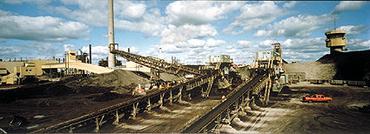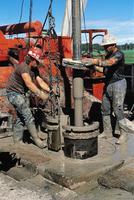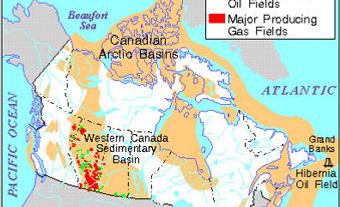Petroleum industries find, produce, process, transport, refine and market petroleum commodities. These commodities include semi-solid bitumen, various types of crude oil, natural gas and natural gas liquids (NGLs) such as ethane, propane and butane. The petroleum industries extract raw resources from the ground and ultimately provide consumers with natural gas heat and products such as gasoline, diesel and jet fuel, kerosene, heating fuel, plastics and fertilizers. As petroleum became the critical energy resource of the 20th century, governments became more intimately involved in the operations of the petroleum industries- especially during the "crisis" years of the 1970s and early 1980s. In Canada, more than 80% of petroleum is found on Crownland, so federal and provincial governments have always had a direct interest in the industry as the owner of the resource.
Compared to other industries, most sectors of the petroleum business are very capital intensive (ie, they require a high proportion of machinery and equipment relative to their labour force) and typically involve higher financial risks. The profitability and level of activity in the industries vary enormously, depending on petroleum supply and demand and competitive market conditions. They are often termed "boom-and-bust" businesses.
A small number of large, vertically integrated companies engage in all activities, from initial petroleum exploration and production to the final retail sale of petroleum products. Several of the largest Canadian integrated companies are subsidiaries of multinational oil companies based in the US, the UK and the Netherlands, although Petro-Canada, created by Parliament in 1975, now rivals the size and scope of the foreign-controlled "majors." There also are 1000 smaller companies that have specialized in one or more sectors; most of these "independents" are Canadian owned.
The Canadian petroleum industry began in Canada West (Ontario) in 1851 when businessman Charles N. Tripp of Woodstock founded the International Mining and Manufacturing Company to exploit the asphalt beds and "oil springs" of Enniskillen Township in Lambton County. It was the first registered oil company in North America. Tripp's asphalt won an honourable mention at the Universal Exhibition in Paris in 1855. In that same year, Tripp sold his company to James Miller Williams, a carriage-maker from Hamilton.
The energetic Williams soon discovered that the deeper he drilled his wells, the more oil flowed into the hole. By 1858, his well was producing significant quantities of crude oil. Williams is sometimes credited as North America's first oil finder. The well, known as Williams No. 1, set off an oil-exploration boom that established southwestern Ontario as a significant oil-production area during the late 19th century. About 18 small refineries were built to convert the oil into buggy-wheel grease and kerosene lamp fuel, which were the major uses of oil until the spread of the automobile in the early 20th century. The oil and products were transported by wagons, railways, barges and pipelines; most retail sales were made by general stores. Hundreds of drillers, producers, shippers, refiners and retailers competed in a boom-and-bust atmosphere until 1880, when 16 producing and refining companies merged to form Imperial Oil.
In 1898 John D. Rockefeller's Standard Oil Trust acquired control of Imperial Oil for $350 000, and Imperial remained a subsidiary of Standard Oil of New Jersey when the trust was split up by American authorities in 1911. Standard of New Jersey, later renamed Exxon, is still the world's largest oil company and continues to own 69% of Imperial. In late 1998 the company announced its intention to merge with the Mobil oil company.
In 1914, when the Royal Navy was worried about the security of its oil supplies, the Canadian government decided to issue crown oil leases only to Canadian- and UK-controlled companies. Imperial Oil circumvented this regulation by acquiring freehold leases from private mineral owners (mainly the Canadian Pacific Railway and the Hudson's Bay Company) in western Canada and by setting up a subsidiary with majority Canadian ownership to exploit oil on Crown leases. As a result, Imperial became a major developer of oil discoveries at Turner Valley, Alta, in 1914 and at Norman Wells, NWT, in 1920. UK-based companies, eg, Royal Dutch Shell and Anglo-Persian Oil (later renamed British Petroleum), expanded their interests in Canada after 1914.
In 1946 domestic wells supplied only 10% of Canadian oil consumption. Canadian companies, eg, Canadian Oil (under the White Rose brand), McColl-Frontenac, British-American, Royalite and Home Oil, reached significant size in the first half of this century mainly as refiners and marketers of oil imported from the US, the Caribbean and Latin America. Then, on 13 February 1947, Imperial Oil discovered the major oil field at Leduc, Alta, beginning the modern era of western Canadian oil production.
A takeover spree by foreign companies in the 1950s and 1960s left virtually all of Canada's integrated oil companies controlled by multinational majors. By the early 1970s over half of the Canadian oil business (whether measured by assets, revenues or retail sales) belonged to units of the 7 biggest multinationals, the "seven sisters": Exxon, Royal Dutch Shell, British Petroleum, Mobil, Texaco, Gulf and Standard Oil of California. In 1973 foreign-controlled companies took in about 90% of petroleum revenues in Canada (see foreign investment).
Since the 1950s foreign ownership had been a growing concern of economic nationalists, consumer groups, socialists, some Canadian oilmen and independent fuel retailers. In 1959, after 2 Royal Commissions urged greater government control of the petroleum industries, Parliament created the National Energy Board to oversee and regulate imports, exports, pipelines and other interprovincial oil and gas activities in Canada. Provincial authorities, eg, the Alberta Energy Resources Conservation Board (incorporated in 1995 into the Alberta Energy and Utilities Board), also regulated the petroleum industries. But the federal government only acted to restrict foreign ownership after October 1973, when the Arab oil embargo set off a quadrupling of world oil prices.
Petroleum-industry ownership remained a major preoccupation for about a decade of "energy crises," then largely disappeared from the public and governmental agendas after the 1984 election, when the Conservatives replaced the Liberals in Ottawa.
The Foreign Investment Review Act of 1974 and the establishment of Petro-Canada in 1975 marked the first efforts to curb the domination of the multinationals, but these were not the first instances of government participation in the petroleum industry. During World War II the government operated a Crown company called Wartime Oils and joined the US in building a pipeline from Norman Wells to the West Coast. In 1967 the government established PanArctic Oils Ltd to explore for oil and gas in the arctic islands. It was a joint venture, Ottawa owning 45% and private companies 55%.
The provinces also were active in the petroleum business: Alberta Gas Trunk Line Company (later Nova Corporation and now part of TransCanada PipeLines) was set up by the Alberta government in 1954 to build and operate gas-transmission pipelines in the province; the equity was later sold to Canadian investors. Another Alberta oil and gas entity, the Alberta Energy Company, was formed in 1975; 50% of the equity was sold to the public immediately, and 50% was retained by the Alberta government and sold in offerings over the next 20 years. Provincial oil corporations also were established by BC, Saskatchewan, Manitoba, Ontario, Québec, Nova Scotia and Newfoundland though most of the assets were subsequently privatized. Petro-Canada was the only one to become fully integrated: its coast-to-coast operations grew to include research and development, exploration and production, pipelines, refineries and retail outlets.
Petro-Canada grew mainly by buying assets from Atlantic Richfield (US controlled, 1976), Pacific Petroleums (US, 1978), Petrofina (Belgian, 1981), BP Canada (UK, 1982) and Gulf Canada Ltd (US, 1985). In 1984, the government revised Petro-Canada's mandate to reduce its role as a public policy instrument; the company was instructed to make decisions on the same basis as other petroleum companies. Through 2 share offerings, in 1991 and 1995, the government sold 80% of the equity to private investors. At year-end 1997, the company and its subsidiaries had 5749 employees, $8.3 billion in assets and $6.1 billion in revenues. It was one of the 3 largest integrated oil companies along with Imperial Oil and Shell Canada.
The foreign-owned multinationals have made substantial contributions to the Canadian petroleum industries. For much of the oil age (eg, 1900-67 and 1974-83), Canada imported more oil than it exported. The world resource base, tanker fleets and marketing expertise of the multinationals delivered most of these imports relatively cheaply and efficiently. The majors provided much of the training in management and technical skills that allowed Canadians to operate their own companies, including Petro-Canada, and to sell their expertise abroad.
The giant companies' financial strength enabled them to carry on long-term, expensive petroleum research and development projects, including the oil-sands processing, offshore and arctic oil exploration, enhanced oil recovery, sour-gas processing, oil and gas transportation, refinery technologies and computer systems. These companies still account for a large proportion of petroleum R&D spending. The multinationals provided much of the financing for projects (eg, oil-sands plants, refineries) that might have been too big and too risky for Canadian capital markets.
Whatever the merits of the multinationals' prominence, the structure of the petroleum industries was altered fundamentally when world oil prices quadrupled in 1973-74 and again when they nearly tripled in 1979. The first concern each time was to ensure adequate oil supplies for Canada. During this "crisis" era, government-to-government deals undermined the trading power of the oil majors. The attention of the federal and provincial governments also focused on the enormous new revenues created by higher prices.
From 1973 to 1985, the federal government controlled oil and gas prices in Canada, generally maintaining them at levels well below the equivalent world oil price. Taxes and royalties diverted 60% of oil revenues to federal and provincial treasuries and to programs designed to cushion consumers from the full impact of world prices. After bitter debate in 1974-75 between the federal and Alberta governments, the federal oil policy remained intact, but a much different policy was adopted for natural gas. Historically low gas prices were allowed to rise rapidly, and less than 40% of gas revenues were funnelled to taxes and royalties.
At the same time, tax provisions allowed investors to get substantial write-offs for investment in oil and gas drilling. The combination of high prices, big profit potential and generous tax breaks set off a huge gas-exploration boom in western Canada in the late 1970s. Canadian companies (eg, Dome Petroleum, Nova, Sulpetro) soared to prominence. Meanwhile the majors were saddled with their many less-profitable oil investments and were effectively barred from new corporate acquisitions by the Foreign Investment Review Act.
The second major reshaping of the petroleum industries came in October 1980, when the federal Liberal government announced a sweeping National Energy Program. The policy further increased the federal taxation of petroleum revenues and took away the tax write-offs that had encouraged drilling in the 1970s. Instead, a Petroleum Incentive Program paid grants to petroleum drillers depending on their Canadian-ownership level and on the location of the wells. The highest PIP grants, up to 80% of actual spending, went for wells drilled in frontier areas by companies more than 75% Canadian owned; there would be no PIP grants at all for companies less than 50% Canadian owned drilling in the provinces.
The NEP was substantially modified in 1981 and 1982 after harsh criticism from the petroleum-producing provinces in western Canada and from the petroleum industries. The NEP, combined with the 15% drop in world oil price 1982-83, led to a sharp decline in petroleum activity in western Canada and to the cancellation or postponement of several proposed megaprojects in the Alberta oil sands. However, exploration activity continued in frontier areas such as the Beaufort Sea, the arctic islands and the East Coast offshore from Newfoundland and Nova Scotia.
The NEP also encouraged Canadian companies to acquire the Canadian operations of foreign oil companies. Amid slumping world oil prices and a general economic recession, the debt-financed takeovers caused financial crises for many of the Canadian oil companies. Nonetheless, Canadian-controlled companies, including Petro-Canada, increased their share of petroleum revenues from 13% in 1977 to 19% in 1980, 28% in 1983 and 48% in 1986.
The Petroleum Monitoring Agency, created in 1980 to analyse ownership trends, was disbanded in 1995; as of its final report, for 1994, Canadian-controlled companies still had a 46.3% share of revenues.
However, the petroleum industries have been dramatically transformed since late 1984, when the Conservative government dismantled the NEP and began deregulating oil and gas prices. In the decade following the sharp drop in world oil prices in early 1986, Canadian oil prices averaged about 55% of the 1985 level, and natural gas prices declined steadily until 1992, when they began to increase again, reaching about 80% of the 1985 level in 1994.
Lower prices prompted major restructuring and downsizing. Prominent names disappeared from the roster of companies: the assets of Sulpetro were acquired by Imperial Oil in 1987, Dome Petroleum by Amoco Canada Petroleum Company Ltd in 1988. New names emerged - eg, Talisman Energy, a widely held company created from the former BP Canada in 1992 after parent BP decided to withdraw from Canada (only to return in 1998 through the merger of BP and Amoco Corp). Other once-tiny companies (eg, Renaissance Energy) became major oil and gas producers. Nova, while retaining its Alberta gas transmission role, also became an international marketer of gas and services and a major producer of petrochemicals. In 1998 Nova's pipeline division was acquired by TransCanada PipeLines, leaving only the petrochemicals division under the Nova banner. Many companies reduced the number of direct employees, placing a greater reliance on outside contractors. With the exception of Imperial Oil, which kept its head office in Toronto, most of the companies in the petroleum industries are headquartered in Calgary.
Because more efficient vehicles drive further between fill-ups and require less frequent repair, the number of service stations declined from about 25 000 in 1980 to about 13 500 in 1997. Sales of gasoline dropped about 15% in the 1980s and remained relatively unchanged in the 1990s. The 3 largest companies (Imperial, Shell and Petro-Canada) account for about half of the service stations, while the remainder are independents, members of retail chains or affiliates of regional companies such as Irving, Ultramar and Husky.
The petroleum industries directly employed around 215 600 Canadians in 1997 and an additional 231 300 indirect jobs provided goods and services for the industries. About half of the jobs involved marketing, which includes heating-fuel deliveries and the operation of retail gasoline outlets. Refinery operations are scattered across Canada, but the main refining centres are Edmonton, Sarnia and Montreal. Petroleum transportation is mainly by pipeline companies based in Calgary and Vancouver.
Upstream production revenues totalled $31 billion in 1997, of which 53% came from the sale of crude oil; the remainder was from natural gas, natural gas liquids and sulphur sales. Downstream petroleum product revenues were about $22 billion, plus an additional $15 billion which the industry collected on behalf of the federal and provincial governments in the form of sales and excise taxes. Gasoline, the most important downstream product, accounted for about 40% of sales.
See also energy policy.

 Share on Facebook
Share on Facebook Share on X
Share on X Share by Email
Share by Email Share on Google Classroom
Share on Google Classroom







